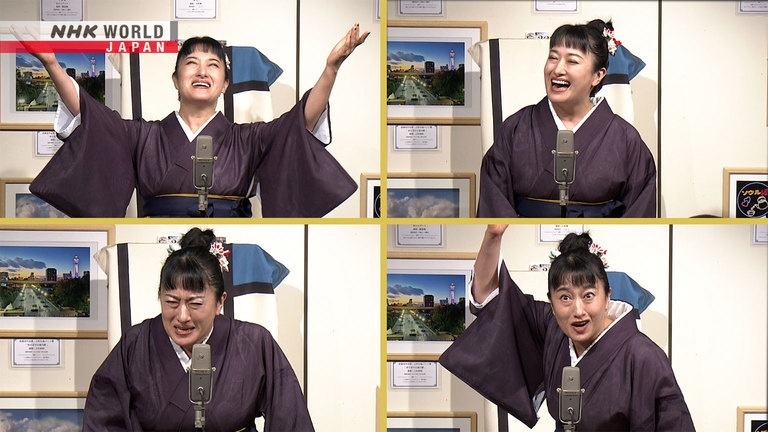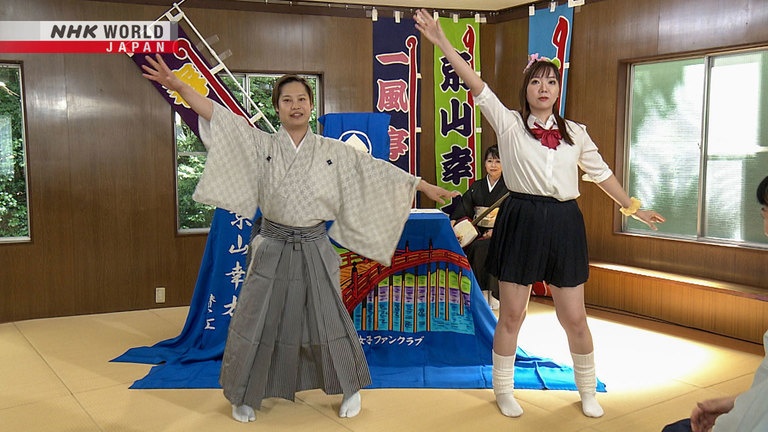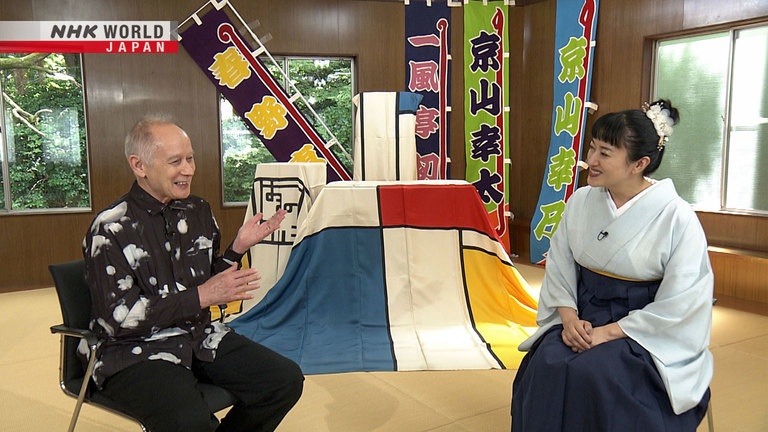Rokyoku: Musical Storytelling
*First broadcast on August 31, 2023.
Sometimes described as "solo opera," Rokyoku was once Japan's most popular form of entertainment, with top performers among the richest people in the land. Rokyoku rose to prominence in the late 19th century, but the advent of TV triggered a rapid decline. Now young performers are revitalizing this storytelling art by incorporating English, rock and pop music, and even dance. Peter Barakan experiences rokyoku in both old and new styles. And in Plus One, Kyle Card tries giving a performance himself.



Transcript
Hello and welcome to Japanology Plus.
I'm Peter Barakan.
Our theme for today is rokyoku,
which is a form of Japanese performing art
where a solo performer tells a story,
partly narrated, and partly sung.
I'm in Osaka, which is where rokyoku
is thought to have been born.
Where I am now is a temple close
to the port of Osaka,
an area where rokyoku
was particularly popular.
And this big stone behind me here
commemorates the style.
There's another stone over here
where the names of some of the big stars
of the past are inscribed.
There's also a festival held here
every August,
where current rokyoku performers
gather together.
To be honest, I know not much more
about rokyoku than you do,
so let's get started.
Rokyoku features singing...
...and also spoken storytelling.
The roles are all performed by one person,
known as a rokyoku-shi.
The performance of one story takes
around 30 minutes.
A shamisen player contributes
to the music and emotion.
The storyteller and musician work together
to draw the audience into the tale.
This time, our guest is
the rokyoku-shi Haruno Keiko.
She was already a household name
as a TV personality
when she happened to see
a rokyoku performance 20 years ago.
It was love at first sight and she was
soon studying the art in earnest.
Haruno is known for her expressive
and powerful storytelling technique.
And she is now an important figure
in the world of rokyoku.
(Story)
It's today! At the Sumida River!
(Story)
This summer's big fireworks display!
(Woman)
I risked everything for this.
(Woman)
My husband made an amazing firework.
(Woman)
That rogue cheated on me, but...
(Woman)
I had to do what's right.
(Woman)
And it lit up the sky over Edo!
(Woman)
I did it! I launched it!
(Husband's father)
She... she did it! What a woman.
(Husband's father)
And with my son in the doghouse.
(Husband's father)
It was the best firework of the evening!
(Woman's father)
Well, that settles everything.
(Woman's father)
Now I'm ready to forgive and forget.
Audience of one.
Is this your first time?
Yes, it is. I mean,
I knew the term “rokyoku,”
but I'd never seen one performed,
so I wasn't really knowing quite
what to expect.
And I'm still not sure
how much of it I understood.
I was getting little bits
of what you said,
but obviously you are doing
so many different voices,
and there's so many
different things going on,
and some of it's spoken
and some of it's sung, and...
so what types of stories are
the most frequent and the most popular?
Stories about bonds of love
between parent and child.
Or tales of loyalty.
Devotion to a lord.
Then there are tales of revenge.
A really broad range of themes.
And I notice the shamisen player
was watching you all the time.
Yes. Well noticed!
It's bit like jazz improvisation.
The player watches how I'm performing,
and the way I'm moving my mouth.
And she adjusts her timing accordingly.
And I noticed you really have an enormous
variety of different voices you use,
from very high, to quite low and fairly
rough sounding male voices as well.
How hard is it to acquire
that vocabulary, if you like?
It's tricky.
When I talk fast like this,
it doesn't project.
And when I try to slow down,
it can be painful.
But keep shredding your vocal cords
and you start to develop those voices.
So...so basically you have
to shred your vocal cords?
Your vocal cords are like this.
They push out the sound.
When you force out this kind of sound,
it strains the vocal cords.
You're deliberately harming them.
The surface gets rough,
and they don't close properly.
The result is a husky voice.
But you still do the very pure
sounding female voices as well.
Yes. That's true.
But you must have some permanent damage
to your vocal cords I'm sure?
It's strange.
I do a deep male voice.
And a high female voice.
When I started, my vocal range
was around this big, let's say.
My speaking voice is now lower.
And my laugh is like this.
The range has become much bigger.
It's very interesting.
First comes the voice, then singing,
then storytelling.
First, you work on your voice.
Then your singing,
and finally, your storytelling.
Those three things, in that order.
And have there always been lots
of female rokyoku-shi performers?
Because in the other kinds of storytelling
it tends to be more men, doesn't it?
Rokyoku is unusual in that regard.
Women have always been involved.
Many of the headline acts,
the real superstars, have been women.
The elderly male maestros know.
They know that there have been
even better female performers.
So “Women can't do it”
is something you never hear.
The work environment is so welcoming.
I didn't know that until I started.
I'd say it's extremely rare, actually.
In the past, storytellers
and shamisen players
would present tales of morality
and the ways of the world.
Rokyoku emerged from this custom
in the mid-19th century,
as a form of street performance.
Street performers were seen as vulgar.
They had no permanent performance spaces
and usually made do with
temporary booths in public places.
If they did appear in a theater,
other performers would complain.
They didn't want to share a stage
with the likes of rokyoku-shi.
They were not respected even
by their peers.
But one man changed all that:
Tochuken Kumoemon.
Not just a powerful storyteller,
he seemed able to sing
without taking a breath.
Kumoemon rocketed to fame.
In 1907,
Kumoemon was given the chance to perform
for members of the Imperial family.
After that, discrimination against
rokyoku faded away.
Kumoemon created many stories focusing
on filial duty and personal heartbreak.
Rokyoku became popular
for exploring states of mind
that people could readily identify
with in everyday life.
For half a century, it was Japan's most
popular performing art,
and rokyoku-shi were among
the richest people in the land.
But then, in the mid-20th century,
the advent of television hit rokyoku hard.
Public attention found a new focus.
I was a little surprised
to see in the video
that in the early days,
rokyoku was looked down on.
What was that about?
Its immense popularity prompted envy
among other performers, perhaps.
And this man Kumoemon
was largely responsible
for its mass popularity, I gather.
He's generally seen as the key, yes.
Rokyoku moved to big theaters,
and he showcased it with stage design.
Its status as an art form rose greatly.
Tochuken Kumoemon made
a huge contribution.
I mean, the fact that he performed
in front of members of the Imperial family
kind of reminded me of when
the Beatles first came along,
and played in front of
the royal family in England.
And in a way,
that changed the way that rock and roll
was seen in the West,
because to begin with
it really wasn't something that was talked
about in polite circles, I don't think.
I mean, it's quite remarkable
that a performing art like this
would have been the most popular kind
of performing art in Japan for a while.
And then
in the age of television,
it loses its popularity, right?
Right. TV has a certain speed to it,
and maybe rokyoku couldn't keep up.
One theory involves the commercials
that TV channels have to show.
They'd want to put one in the middle of
a 30-minute performance on TV.
“I will not allow a commercial
to interrupt my performance.”
As that was the Rokyoku position,
it came to be seen as a bad fit for TV.
That's what people say, at least.
How many performers are there?
In the region around Osaka,
there are about 20 of us.
And nationwide, you won't find more
than 100 performers, I'd say.
Rokyoku may not be as popular
as it once was in Japan,
but Haruno has been traveling the world,
finding a new audience
for the craft she treasures.
She began in 2014 with a show in New York,
and has since been to places
like China, Italy, Russia and Mongolia.
How was it received?
At that very first show outside Japan,
in New York, I was really worried.
What if people don't get it
and simply glaze over?
But at the end of the first show,
they seemed to have enjoyed it.
Since then, I haven't been nervous
about performing overseas.
All I have to do is entertain
the audience in front of me.
It really does feel just
like business as usual.
I'm very intrigued.
Can you do a little demonstration
for us in English?
Well, I translated the whole of
a story called Bancho Sarayashiki.
It's very well known.
Here's an excerpt in Japanese.
Now I'll do that bit in English.
Kiku, you may stay here.
Five dishes in a box,
Sen takes them away.
And Kiku was left alone.
Her heart was confused.
Deep in her thought.
That's what it sounds like in English.
And obviously your English vocal skills
are well honed as well.
We probably should have done
this interview in English.
Hello everyone, and welcome to Plus One.
I'm Kyle Card.
Now today, we've been covering
all things rokyoku.
And because I have some confidence
in my vocal capabilities,
I've decided to try a rokyoku lesson.
In preparation, I'm already decked out
in traditional Japanese garb.
So let's get right to it,
because class will soon be in session.
This looks like the place.
My name is Kyle, and I came here today
to learn some rokyoku techniques.
Would you be able to teach me some?
I'm Tamagawa Nanafuku.
And this is Sawamura Mami.
Nice to meet you.
First, we'll work on your voice.
It has to stay strong throughout.
You don't simply use your throat.
It comes from deep inside.
You can really hold the sound.
You need to do high sounds, too.
We'll build up your range,
and work on different voices.
First, the voice!
From deep down, produce this sound.
Mmmm.
Not in tune with the shamisen.
Mmmm.
Good.
Mmmm.
OK.
Oh, great.
Next, we'll practice storytelling.
“First, this and then that.”
“One thing led to another,
then this happened.”
And here's how you should perform it.
Wow.
“First, this...”
What's with this voice?
- Too much.
- Ah, too much.
- Really?
- Perfect!
Whoa! Yeah!
Fantastic!
Really?
Can't do it.
Kyle undergoes two hours of intensive
training on vocalization and storytelling.
Let's see what he's learned.
Thank you for coming.
I offer you a warm welcome!
I will perform Kyle's Story,
and so let's begin.
First, this and then that.
One thing led to another,
then this happened.
That's all we have time for.
So I'll stop here.
How was it?
Perfect!
You were great.
Thank you so much
for taking the time to
teach me all of these wonderful techniques
that I haven't quite mastered,
but I truly appreciate it.
Thank you for giving it a go!
It was fun.
Really?
Absolutely!
Thank you so much.
Alright, so it's said it take three years
to master the singing,
an additional five years to master
like the storytelling and dictation,
and I practiced all that in one day,
and well...I did OK.
But it felt great to really sing
with all of my heart,
at the top of my lungs, and there's
nothing more cathartic than that.
So I think I might be practicing this
in the shower at home later.
In the second half of the 20th century,
rokyoku was in decline.
But then a revolutionary figure appeared.
Kunimoto Takeharu.
He created a unique style that involved
playing the shamisen like a guitar.
He also incorporated rock,
R&B and bluegrass into his performances.
This groundbreaking approach inspired
many young people
to take an interest in rokyoku
for the first time.
The fan base grew.
Rokyoku performers are not expected
to be slaves to tradition.
The focus is more on developing
unique forms of expression.
Kunimoto breathed new life into the art.
But in 2015, at just 55 years of age,
he fell ill and died.
It was another serious blow for rokyoku.
For a time,
there was concern that the resurgence
Kunimoto had led would come to an end.
But then young performers inspired
by Kunimoto began to appear.
Kyoyama Yukino is one of them.
I'm close to 10 years old.
Ah, so you're 8 or 9?
I'm 12!
And a rising male star is Kyoyama Kota.
He writes original stories
to suit modern times.
We're going to hear an excerpt from one
about girls in a high school dance group.
They tackle many challenges
as they strive to win a big competition.
- This is insane.
- Totally crazy!
You can tell just by looking.
This is a trendy “girls' circle.”
“Girl-cir” for short.
Hit the music!
The show even features Para Para,
a form of dancing that was once
all the rage among high school girls.
Every generation is different,
producing strange new species.
Who are the stars of today?
Wow. That was surreal, in a word.
Where did you get the idea
for the piece you've just performed?
People of my generation
know nothing about rokyoku.
I wanted to appeal to them.
And I thought it would be good
to incorporate visual impact.
I spent a long time looking for
some kind of dance or performance.
Then I saw a TV drama.
It was about teenage girls.
It seemed a perfect fit,
and that's how it started.
Do you actually get young audiences
coming to see you?
The usual audience is 70 and over.
So now it's a bit more youthful, maybe.
But I'd love for more young people
to come along and see the show.
These days, people watch
extremely short content.
At 15 to 30 minutes,
rokyoku is relatively long.
But today's high pace is exhausting.
I think people might like to slow down
and savor something.
So I'm aiming for candid emotion
and power in my performances.
What we just heard Kota-san do,
that was, again,
totally not something
I was expecting to hear.
Yes, isn't it fun!
Do you think that rokyoku needs
that kind of input in this period?
I'd love for younger performers
to take on lots of new challenges.
That way, they'll make new discoveries.
I myself have performed in English.
I've incorporated modern music.
My mentors supported me,
and encouraged me to continue.
I've used well-known modern songs
as the backing for a rokyoku show.
But the stories were traditional.
One was by Ihara Saikaku in the 1600s.
A woman is accused of having
an affair with someone else's husband.
It's not true. It's a stitch-up.
So she denies it by saying “enzai.”
It means “false accusation.”
But I had her sing “enzai” like this.
Thank you very much.
A short excerpt for you.
That's amazing.
I certainly wasn't expecting
anything like that.
You know, it's interesting...
people, when they try to explain
what rokyoku is to people
who've never heard it,
they talk about like, solo opera,
and I'm going, what?
And hearing what you just did,
it kind of clicked.
It is, it's almost like solo opera.
Or, I mean, I suppose opera is...
it's a European tradition.
Then you have musicals
which is very much an American thing.
And then you've got rokyoku
which is totally different,
but I suppose in Japan,
and in an earlier period,
it was perhaps a very similar thing.
And also very much a thing
of the common people.
So I guess that was probably a big factor
in why it was so popular.
I'm glad you enjoyed it.
Interesting, interesting.
- Thank you very much.
- Thank you.